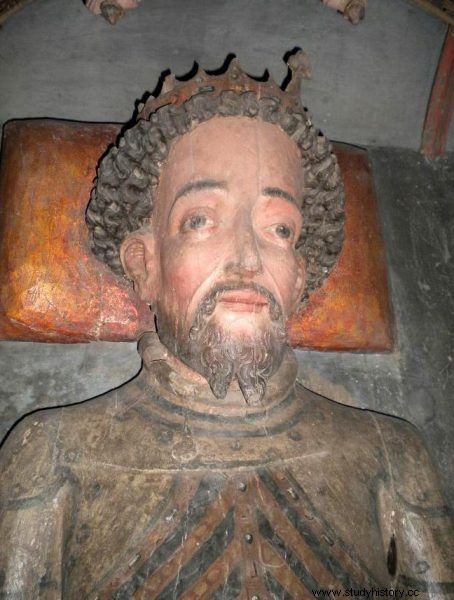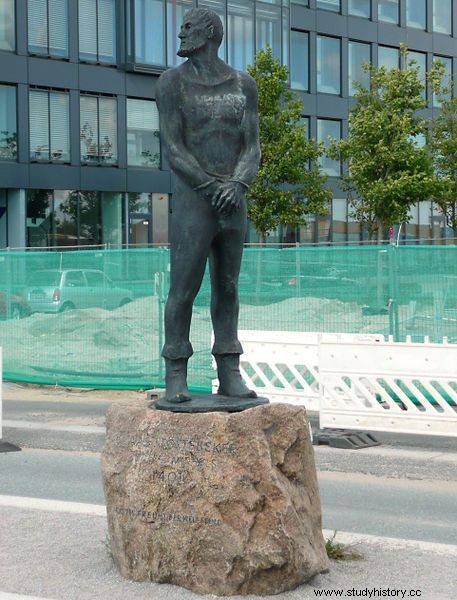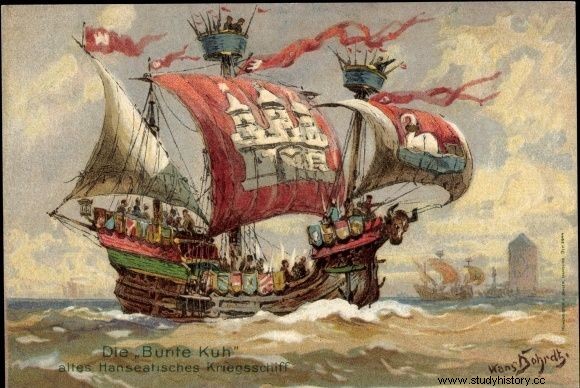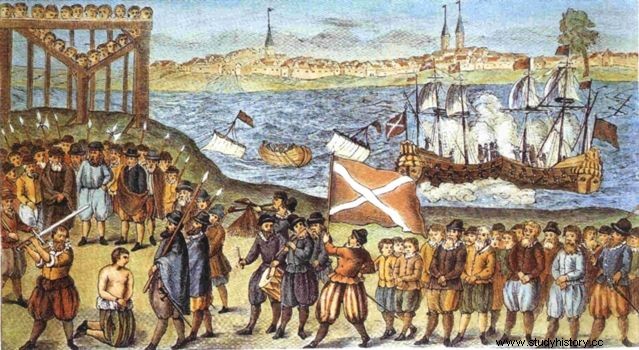Everyone has heard about pirates - dangerous bandits attacking ships with pure gold and precious objects in their holds. Boardings, pirate eye-patches, parrots etc. And all this in the paradise scenery of the Caribbean Islands. However, we do not have to go that far, because at the turn of the 14th and 15th centuries, pirates called the Vitali Brothers were active in the Baltic Sea.
The so-called "Shore law" stating that you can seize the cargo of a stranded ship, but only and only in the event of the death of all crew members. It comes as no surprise then that pirates were eager to show ships the way towards the sandbank (e.g. by means of fires). They could easily become owners of goods carried by sea; it was enough to kill the crew.
Food delivery
Albrecht Meklembruski (king of Sweden in the years 1364-1389), shortly before his captivity in Denmark, hired a group of criminals to supply the besieged Stockholm by the Danes. They mainly provided food (victuals) hence probably the origin of their name :they were called "vitaliebröder" in Swedish. The Witalijscy brothers - because such a name was adopted over time - had more and more strength, and the fleet grew. This made it possible to launch attacks on ships sailing in the Baltic Sea.

Albrecht Meklembruski
In the 1490s, they plundered Bergen and Malmö, as well as towns on the shores of Finland and today's Leningrad Oblast (Turku and Vyborg). They chose the city of Visby in Gotland as their headquarters.
The Hanseatic Problem
The cities that traded with each other, associated with Hansa, had a real problem with the Witalijski Brothers. As a result of piracy activities, prices have increased and the turnover of goods has also decreased. Trade has been paralyzed. It is enough to quote the data:the price of herring increased from 16 to 72 Lübeck marks (35,000 tons of this fish was sent annually to Lübeck, and as a result of the activity of the Witalijski Brothers - 5,000). The Danish queen - Margaret - tried to fight the marauding pirates, even asking for help from the King of England, Richard II. The latter, however, refused as he was afraid of losing a large part of his fleet.
Teutonic Knights and a half and a half
The Witalijscy Brothers, also known as "Likedeelers" (equally dividing) initially engaged in legal piracy, or privateership . However, they gave up private letters (written authorizations for sinking and robbing enemy ships, granted by governments) to be able to get rich faster and more.
The commander-in-chief of this group was Klaus Störtebecker (born in 1360 - died on October 20, 1401), who was legendary about during his lifetime. He was supposed to rob the rich and distribute stolen goods to the poor; beautiful version of the Baltic Robin Hood . In the sources, we can find information that pirates were respected by fishermen and inhabitants of poorer coastal towns, because they (in return for information about the location of ships from other countries) received certain goods - valuables or goods.

Klaus Störtebecker
At the end of the 14th century, when Margaret I (ruler of Denmark) was ending the war for Sweden, the Teutonic Knights under the command of Konrad von Jungingen (Ulrich von Jungingen's brother who died in the Battle of Grunwald) set out on Gotland. This was dictated by the conclusion of the Kalmar Union between Sweden, Denmark and Norway. The Teutonic Knights had to face the emerging competition. The fleet consisted of more than 80 ships (about 4,000 troops) and reached Gotland on March 21, 1398, near the pirate castle of Västergam. The attack turned out to be such a big surprise, the pirates quickly capitulated. The Teutonic Knights quickly reached Visby, here the siege was carried out from land and sea. The city was captured on April 5. In the following years, the island was defended by the Teutonic Knights during a year-long war with Denmark and Sweden.
Meanwhile, the Witalijscy Brothers were driven out of this region of the Baltic Sea , some took refuge in the north, the rest located near Bornholm. Most, however, sailed through the Kattegat, eventually taking refuge in the narrow bay of Schei.
Hunting
Pirates, located in various parts of the Baltic Sea basin, tried to somehow work together, but it was not an easy task. The Hanseatic League wanted to take advantage of the weakening of the Vitaly Brothers. The number of pirates was estimated at around one and a half thousand. In 1400, the so-called Peacekeepers who searched the coast of Friesland (a historic land in today's Germany, Denmark and the Netherlands). More than 100 pirates have fallen into justice this year.
A year later in Hamburg (a city belonging to the Hanseatic League) came up with the idea of creating a masked ship that would look like a merchant, but would actually be a powerful warship at the head of the fleet hunting the Vitaly Brothers. This idea was proposed by the city councilors Nikolaus Schocke and Hermann Lange.

The idea of creating a masked ship turned out to be a bull's eye
The ship that was built was called "Bunte Kuh", or "Latin cow". The idea of disguising the ship turned out to be a bull's eye; the pirates were ambushed near the island of Heligoland . The action was led by Simon van Utrecht, a famous Dutch sailor. 70 pirates were captured and 40 were killed. The commander Klaus Störtebaker fell into the hands of the Hanseatic League. The pirates faced trial and the death penalty by beheading. The sentence was carried out on the Hamburg island of Grasbrook, and the heads of the convicts were impaled and erected along the Elbe.
There is a legend related to the beheading of a pirate leader. As the sentence was about to be carried out, Klaus asked the then mayor of Hamburg to save the lives of those he would bypass just after beheading . The mayor agreed. Klaus was beheaded and, according to legend, he walked along 11 convicts until the executioner laid his leg on him (according to various sources, it could also have been a trunk thrown at his feet). Ultimately, however, the mayor ordered all the pirates beheaded.

The execution of the Witalijski brothers in 1401
Pirate fate
The Witalijscy brothers, although greatly weakened, continued to prowl the Baltic Sea. In the 20s of the 15th century, they plundered Bergen. In the following years, they were less and less active, in the North Sea they were fought until the end of the 1880s.
However, this pirate organization survived in memory and culture. Mecklenburg folk songs often referred to the Witalijski Brothers, and in later years theatrical plays and even operas praising the achievements of pirates (mainly supporting the poor and fighting against the authorities) appeared. In the 20th century, ships and merchant ships were named after the commander of the Vitaly Brothers, and during World War II, the Nazis eagerly used the myth of good pirates (having private letters, they could have lawfully attacked their neighbors).
One of the bases of the Witalijski Brothers was reportedly also in Poland, more precisely in Rowy.
